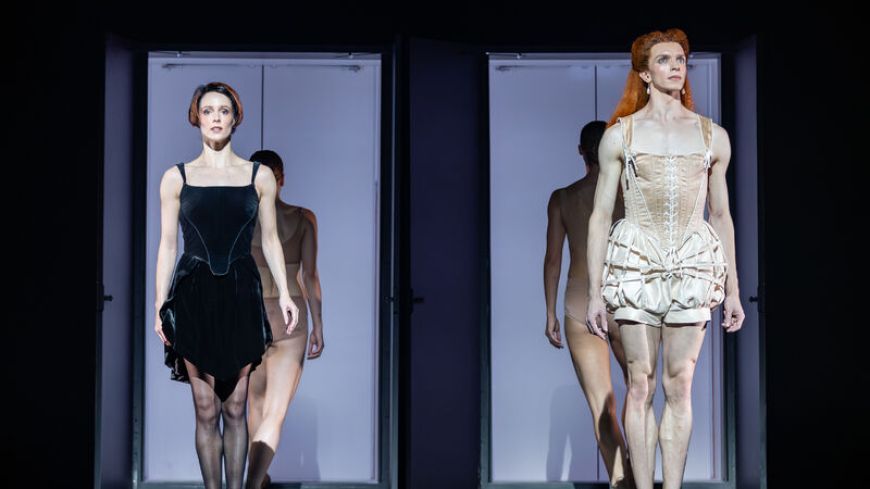
A story of power, intrigue and betrayal, Elizabeth I and Mary Queen of Scots, two of the greatest figures of the 16th century were rival Protestant and Catholic cousins who ruled over their separate Queendoms across one small island.
The daughter of Henry VIII, Elizabeth became Queen of England in 1558, aged 25. Mary Stuart was just six days old when her father James V was killed and she inherited the Scottish crown, but through her direct bloodline to the Tudor dynasty, she believed she was the rightful heir to be Queen of England.
24th March, 1603, in morning shadow, snow is falling as Elizabeth, frail, wigless with wispy white hair, dressed in just her frilly underwear, faces imminent death. Time to reflect and remember.
This colourfully impressionistic portrait of Mary Queen of Scots is dramatised through flashback, dreamlike scenes viewed from Elizabeth’s perspective. Mary is just 15 years old when she marries Francis, Dauphin of France and soon, briefly, the Queen Consort – symbolising the vital alliance between two Catholic nations: a vivacious young girl, an image of Parisian chic is seen joyfully pirouetting in her LBD as the French court showcases their sophisticated silk and lace Chanel-Dior couture.
While the older Elizabeth – the graciously imperial Charlotta Ӧfverholm - observes the action in her mind, her younger self is performed with brilliant shape shifting, gender fluidity by Harvey Litttlehood. Towering over the courtiers, she parades elegantly on high stilts, reflecting her power and dominance as a quietly ruthless Queen, akin to the tall, redhead rebel leader, Boudica. Embracing the New Renaissance / Punk era, expect a fabulous fashion catwalk of crinoline gowns, doublet and hose, Westwood punk ruffs, armour corsets and Mohican haircuts.
In Shakespearian style, her advisor, entertainer and boudoir maid, is a lime green impish Jester, tumbling about with clownish glee. Looking back at her life, of rejoice and regret, she is a lost Lear figure accompanied by her loyal Fool.
A widow aged 18, Mary returns to Scotland to take the throne, surrounded by her Palace courtiers in mauve-heather costumes, where she is drawn into the centre of ensemble dance formations with foot tapping Ceilidh rhythm. A dynamic duet between Mary and her husband Darnley is choregraphed as an intimate tango, legs and limbs intertwined with sensual embrace. Her romantic life swiftly moves through a few passionate love affairs to treacherous murder. Elizabeth envisages Mary like a giant spider to devour and destroy Darnley and is now plotting revenge to gain the English crown.
The eclectic orchestral score by American composers Mikael Karlsson & Michael P Atkinson, seamlessly flows along, switching in an instant between grand Regal processional march, Scottish country dance jig and electro-acoustic beat: think Handel/Purcell meets Nyman /Glass in harmonious Baroque hip hop manner. Marrying music and movement, the double act of Sophie Laplane and James Bonas blends artistically immersive theatricality with inventive, cool, crisp choreography described as ‘neo-classical quirkiness.”
Elizabeth and Mary never met in person but here the women are seen side by side but apart. In one stunning scene, they stand proudly on two revolving platforms as they whirl and twirl across the stage like Fairground waltzers, unable to physically acknowledge each other’s presence.
The drama intensifies as Elizabeth’s spies lurk in the sidelines like an army of scurrying ants to watch Mary’s every move, sending back secret messages in graffiti code to London. Within a versatile, elevating box frame, the black and white design is like a chess board on which the English Queen is ready to capture Mary as a pawn. A giant cage descends from the rafters to entrap Mary like a bird.
This is a visually exciting narrative ballet with sublime music, choreographed with dreamlike imagination. However, with a limited synopsis and no cast list in the free programme, (complete plotline is only on the EIF website), double role playing, characterisation and storytelling needs more clarification to follow the historical time line of the drama.
Roseanna Leney portrays her intense emotional journey from a vulnerable adolescent to influential monarch through feelings of love, heartbreak, betrayal and fear with delicate sensitivity. Finally condemned to death, she remains elegantly regal, crucifix in hand as the ultimate Catholic martyr.
Mary gets her head chopped off to prevent her succeeeding Elizabeth, but in a bitter ironic twist, Mary's son James VI is crowned King James I of England to form a United Kingdom. The tragic tale of the two Queendoms is over.
After other recent epic productions, A Streetcar Named Desire, Coppelia and The Crucible, 'Mary, Queen of Scots' is another magical, truly majestic, theatrical masterpiece for Scottish Ballet.
Showtimes:
15 – 17 August, 2025 @ 7.30pm. Matinees:16th, 2.30pm, 17th, 3pm.
Ticket prices: from £18
https://www.eif.co.uk/events/mary-queen-of-scots
Scottish tour Autumn 2025
https://scottishballet.co.uk/whats-on/mary-queen-of-scots/

